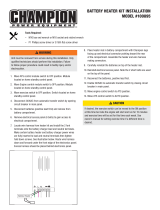Generac
®
Power Systems, Inc. 3
ELECTRICAL HAZARDS
• All generators covered by this manual produce
dangerous electrical voltages and can cause fatal
electrical shock. Utility power delivers extremely
high and dangerous voltages to the transfer switch
as does the standby generator when it is in opera-
tion. Avoid contact with bare wires, terminals, con-
nections, etc., while the unit is running. Ensure all
appropriate covers, guards and barriers are in
place before operating the generator. If work must
be done around an operating unit, stand on an
insulated, dry surface to reduce shock hazard.
• Do not handle any kind of electrical device while
standing in water, while barefoot, or while hands
or feet are wet. DANGEROUS ELECTRICAL
SHOCK MAY RESULT.
• The National Electrical Code (NEC) requires the
frame and external electrically conductive parts of
the generator to be connected to an approved earth
ground. Local electrical codes also may require
proper grounding of the generator electrical system.
• After installing this home standby electrical sys-
tem, the generator may crank and start at any time
without warning. When this occurs, load circuits
are transferred to the STANDBY (generator) power
source. To prevent possible injury if such a start
and transfer occur, always set the generator’s
AUTO/OFF/MANUAL switch to its OFF position
before working on equipment and remove the 5A
and 15A fuses from the generator control panel.
• In case of accident caused by electric shock, imme-
diately shut down the source of electrical power. If
this is not possible, attempt to free the victim from
the live conductor. AVOID DIRECT CONTACT WITH
THE VICTIM. Use a nonconducting implement,
such as a rope or board, to free the victim from the
live conductor. If the victim is unconscious, apply
first aid and get immediate medical help.
• Never wear jewelry when working on this equip-
ment. Jewelry can conduct electricity resulting in
electric shock, or may get caught in moving com-
ponents causing injury.
FIRE HAZARDS
• For fire safety, the generator must be installed and
maintained properly. Installation always must
comply with applicable codes, standards, laws and
regulations. Adhere strictly to local, state and
national electrical and building codes. Comply
with regulations the Occupational Safety and
Health Administration (OSHA) has established.
Also, ensure that the generator is installed in
accordance with the manufacturer’s instructions
and recommendations. Following proper installa-
tion, do nothing that might alter a safe installation
and render the unit in noncompliance with the
aforementioned codes, standards, laws and regu-
lations.
• Keep a fire extinguisher near the generator at all
times. Extinguishers rated “ABC” by the National
Fire Protection Association are appropriate for use
on the standby electric system. Keep the extin-
guisher properly charged and be familiar with its
use. If there are any questions pertaining to fire
extinguishers, consult the local fire department.
EXPL
OSION HAZARDS
• Do not smoke around the generator. Wipe up any
fuel or oil spills immediately. Ensure that no com-
bustible materials are left in the generator com-
partment, or on or near the generator, as FIRE or
EXPLOSION may result. Keep the area surround-
ing the generator clean and free from debris.
• Gaseous fluids such as natural gas and liquid
propane (LP) gas are extremely EXPLOSIVE.
Install the fuel supply system according to applica-
ble fuel-gas codes. Before placing the home stand-
by electric system into service, fuel system lines
must be properly purged and leak tested according
to applicable code. After installation, inspect the
fuel system periodically for leaks. No leakage is
permitted.
STANDARDS INDEX
In the absence of pertinent standards, codes, regula-
tions and laws, the published information listed
below may be used as installation guide for this
equipment.
1. NFPA No. 37, STATIONARY COMBUSTION
ENGINES AND GAS TURBINES, available from
the National Fire Protection Association, 470
Atlantic Avenue, Boston, MA 02210.
2. NFPA No. 76A, ESSENTIAL ELECTRICAL SYS-
TEMS FOR HEALTH CARE FACILITIES, avail-
able same as Item 1.
3. NFPA No. 54, NATIONAL FUEL GAS CODE,
available same as Item 1.
4. NFPA No. 58, AMERICAN NATIONAL STANDARD
FOR STORAGE AND HANDLING OF LIQUEFIED
PETROLEUM GAS, available same as Item 1.
5. NFPA No. 70, NFPA HANDBOOK OF NATIONAL
ELECTRIC CODE, available same as Item 1.
6. Article X, NATIONAL BUILDING CODE, available
from the American Insurance Association, 85
John Street, New York, N.Y. 10038.
7. AGRICULTURAL WIRING HANDBOOK, available
from the Food and Energy Council, 909
University Avenue, Columbia, MO 65201.
8. ASAE EP-3634, INSTALLATION AND MAINTE-
NANCE OF FARM STANDBY ELECTRICAL SYS-
TEMS, available from the American Society of
Agricultural Engineers, 2950 Niles Road, St.
Joseph, MI 49085.
9. NFPA No. 30, FLAMMABLE AND COMBUSTIBLE
LIQUIDS CODE, available same as Item 1.
IMPORTANT SAFETY INSTRUCTIONS
Generac Air-cooled 7 kW, 12 kW and 15 kW Generators




















